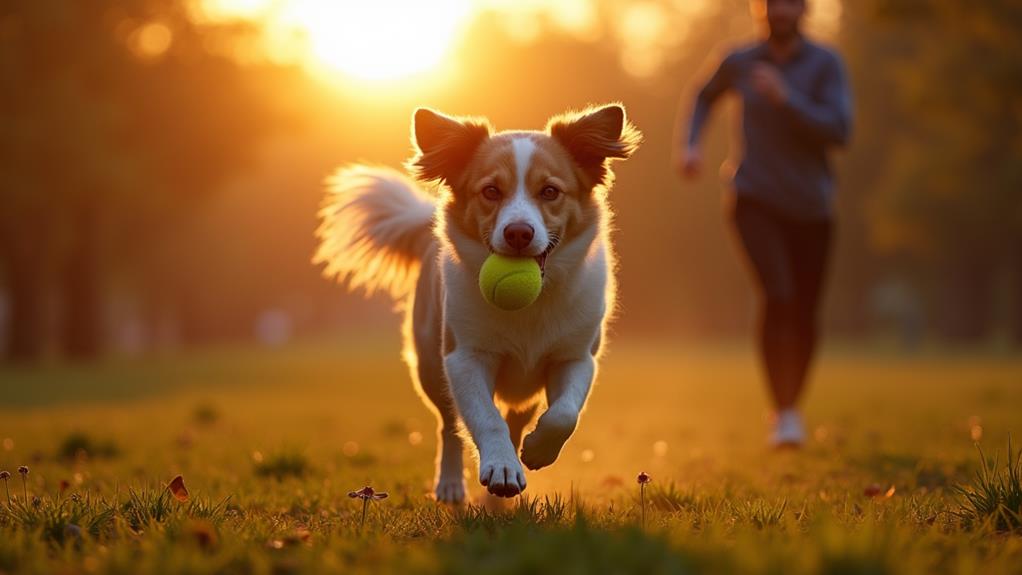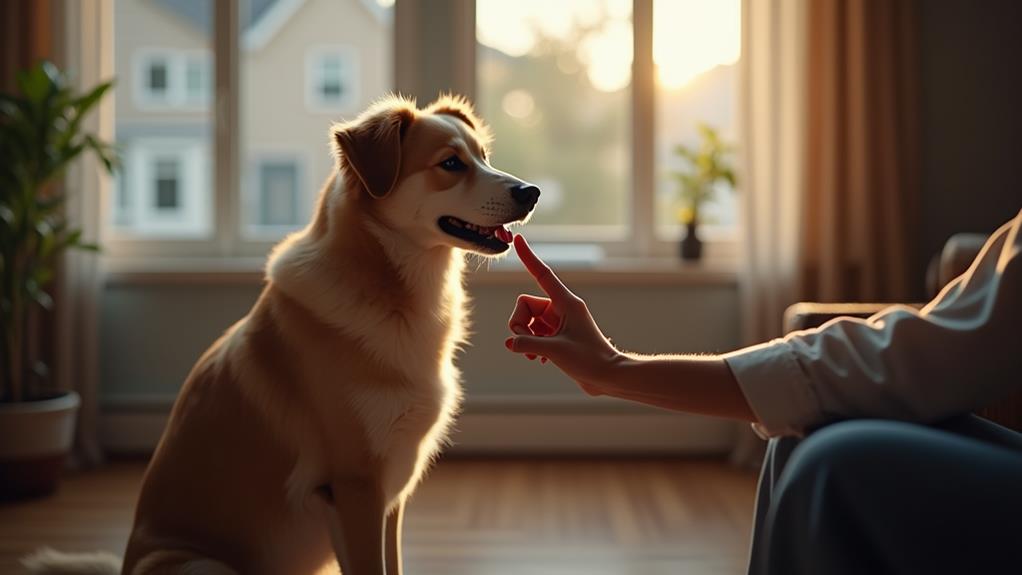
Stop Excessive Dog Barking
To stop excessive dog barking, ensure your dog gets plenty of exercise through regular walks, runs, or playtime. Socialization is critical, so expose your pup to various people and pets to reduce anxiety-related barking.
Provide engaging toys and puzzles to keep their minds occupied when you’re away. Minimize visual triggers and offer a cozy retreat to create a calm environment.
Train your dog to respond to the “quiet” command, consistently rewarding silence. Remember, addressing the root cause of barking, whether boredom, fear, or attention-seeking behavior, is essential. With patience and the right approach, you’ll be on your way to a more peaceful home.
Points To Consider
- Exercise your dog regularly to release energy and reduce boredom-induced barking.
- Socialize your dog with people and pets to minimize anxiety-related barking.
- Provide engaging toys and puzzles to keep your dog mentally stimulated and less prone to bark.
- Create a calm environment by minimizing triggers and providing a comfortable space for your dog.
- Train the “quiet” command and consistently reinforce the desired behavior to manage excessive barking.
Exercise Your Dog Regularly

Release your dog’s energy through regular exercise to curb excessive barking. By providing your canine companion with consistent physical activity, you’ll tire them out, making them more likely to rest peacefully when you’re away. This simple strategy can significantly reduce problem barking and create a calmer home environment.
Incorporate outdoor adventures into your routine to combat boredom, a common trigger for excessive barking. Take your dog on daily walks, runs, or hikes to provide a constructive outlet for their energy.
Consider exploring dog sports like agility or flyball to mentally and physically challenge your pet.
If your schedule is hectic, don’t hesitate to hire a dog walker for mid-day exercise. This guarantees your dog receives necessary activity even when you’re busy.
During colder months, an indoor dog treadmill can be an excellent alternative to maintain your pet’s exercise routine.
Socialize With People and Pets
While exercise addresses your dog’s physical needs, socializing tackles their emotional well-being. Exposing your companion to various people and pets can significantly reduce barking tendencies. Creating positive experiences with diverse individuals, including mail carriers and delivery personnel, will help diminish your dog’s fear and anxiety in new situations.
Start socializing your puppy early to prevent excessive barking habits as it ages. Regularly introduce your dog to different environments and situations to build its confidence in social settings. This approach minimizes fear-based barking and helps your dog become more adaptable.
Consider these socialization strategies:
| Strategy | Benefits |
|---|---|
| Neighborhood walks | Exposure to various sights, sounds, and smells |
| Playdates | Interaction with other dogs in controlled settings |
| Group training classes | Structured socialization with people and pets |
Provide Engaging Toys and Puzzles

How can you keep your dog’s mind occupied and reduce excessive barking? The answer lies in providing engaging toys and puzzles that offer cognitive stimulation.
Interactive toys, especially those that dispense treats, can significantly decrease barking by keeping your canine companion mentally engaged and focused.
Puzzle toys that challenge your dog’s problem-solving skills entertain and stimulate cognitive function, helping to alleviate boredom-related barking.
Regularly rotating various toys will prevent your pet from losing interest and encourage continued play, effectively distracting them from potential barking triggers.
To maximize the benefits of engaging toys and puzzles:
- Choose interactive toys that dispense treats or require problem-solving
- Rotate toys frequently to maintain novelty and interest
- Use puzzles during times when you’re away to minimize anxiety-induced barking
Studies show that dogs with access to mentally stimulating toys exhibit calmer behavior and lower stress levels, reducing excessive barking.
Create a Calming Environment
Your dog’s environment plays an essential role in managing excessive barking. To create a calming atmosphere, start by introducing soothing sounds. Turn on a radio or TV at a low volume to provide familiar background noise to help your beloved companion feel more at ease when left alone.
Next, minimize visual triggers that might provoke barking—close blinds or curtains to reduce outside distractions, creating a more serene space for your dog.
Maintain a tidy and organized area to limit potential sources of anxiety and promote a sense of calm.
Establish a cozy retreat for your pet by providing comfortable bedding and favorite toys. This secure space will help your dog feel safe and relaxed, reducing the likelihood of stress-induced barking.
Train the Quiet Command

Training your dog to respond to the “quiet” command is essential in managing excessive barking. To teach this command effectively, wait for a moment of silence from your dog, then use a calm but firm voice to say “quiet” while immediately rewarding them with treats. Consistency is vital, so practice this command to reinforce the behavior in various situations.
When implementing the “quiet” command, remember these key points:
- Timing rewards: Offer treats immediately after your dog stops barking to create a clear connection between the command and their behavior.
- Avoid reinforcing barking: Don’t respond to your dog when they bark, as this can inadvertently encourage the behavior.
- Distraction training: Gradually increase the level of distraction during training sessions to help your dog remain quiet in stimulating environments.
Pair the “quiet” command with positive reinforcement to strengthen the association between the desired behavior and rewards.
As you progress, practice in different settings to help your dog understand when to be quiet. By consistently applying these techniques, you’ll help your canine companion develop better control over their barking habits, creating a more peaceful environment for both of you.
Frequently Asked Questions
How Do I Stop My Dog From Obsessively Barking?
Identify your dog’s barking triggers and address them through consistent training techniques. Use positive reinforcement to reward quiet behavior. Provide mental stimulation and exercise to reduce boredom-related barking. Stay patient and persistent in your approach.
How Do You Discipline a Dog to Stop Barking?
You shouldn’t “discipline” a dog to stop barking. Instead, use positive reinforcement and behavior modification techniques. Reward quiet behavior, ignore barking, and provide mental stimulation. Consistency and patience are crucial to changing your dog’s vocalization habits.
Why Does My Dog Bark So Much for No Reason?
Your dog’s “no reason” barking likely has triggers you’re missing. Dogs use barking as communication signals. Observe closely to identify what’s prompting the behavior. Once you understand the cause, you can address it effectively.
Can I Squirt My Dog With Water to Stop Barking?
While you can use a water spray for bark training, it’s not recommended. It’s a temporary fix that doesn’t address underlying issues. Instead, focus on positive reinforcement and redirection techniques to effectively manage your dog’s barking behavior in the long term.
The Article: Stop Excessive Dog Barking Was Found On https://happypetsgroomingtable.com/
The Article Stop Excessive Dog Barking First Appeared ON
: https://ad4sc.com












It’s really interesting to see how much our dogs’ behavior can reflect their environment and daily activities. I’ve found that my own pup, a rescue with a bit of a bark problem, has improved significantly since we started incorporating more structured playdates with other dogs. Socialization, as you mentioned, has truly been key in reducing her anxiety and excessive barking. I also appreciate your focus on mental stimulation—providing puzzle toys has helped keep her busy while we’re at work.
It sounds like you’ve found a great balance for your pup. Socialization really does work wonders in helping to alleviate anxiety; it’s fascinating how much dogs can learn from each other. I think playdates are such a wonderful way to not only give them exercise but also to help them develop important social skills. It’s a bit like taking them to a class where they can learn from their peers.
I really appreciate your perspective on socialization for dogs. It’s true how much they can learn from each other. I’ve noticed that when my pup spends time with other dogs, he picks up on different play styles and behaviors that I sometimes wouldn’t have thought to teach him. It’s almost like a little community learning experience.
You’ve touched on such an important aspect of dog ownership. I think it’s fascinating how our pups learn from one another in social settings. Your observation about different play styles really resonates with me. I remember when my dog first interacted with a retriever; he learned to fetch in a whole new way. It’s almost as if these interactions serve as little lessons in social cues, not just for play but also for understanding boundaries and communication.
It’s so true how those interactions can shape our dogs in so many ways. I think the variety in play styles is like a mini classroom for them. Watching your dog pick up a new skill like fetching from a retriever is such a perfect example of how they adapt and learn from each other.
I completely relate to your observations about how dogs can learn from each other during socialization. It’s fascinating to watch them interact and pick up on different play styles; each dog has its unique mannerisms and quirks. I’ve noticed that my dog, too, seems to adapt based on who he’s playing with.
It’s interesting how dogs can really mirror each other’s behavior, isn’t it? I’ve noticed this with my own dog as well; he tends to pick up quirks and play styles from his canine friends. It’s almost like they’re communicating in a language we can’t fully understand. I remember a time at the dog park when he started mimicking one of his buddies who had a very playful way of rolling around in the grass—it was hilarious to see him try to imitate it, even though he had his own style!
It’s great to hear about your dog’s progress. It sounds like those structured playdates are really paying off. It’s amazing how much socialization can help them feel more confident and comfortable. Rescue dogs sometimes come with their own set of challenges, and it’s fantastic that you’re creating an environment where she can thrive.
I really appreciate you saying that. It’s been a journey figuring out what works best for her, but seeing her confidence grow during those playdates is really rewarding. I’ve noticed how much she reflects the energy of the other dogs; when they’re excited and playful, she tends to loosen up.
It sounds like you’re really in tune with her needs, and it’s great to hear how those playdates are making such a difference. The way dogs mirror each other’s energy is fascinating, isn’t it? It makes you realize how much their interactions can shape their behavior and confidence.
It sounds like you’ve got a real canine social butterfly on your hands! It’s fascinating how much dogs can mirror the energy around them. I mean, if you’ve ever seen a golden retriever get into the spirit of things, it’s like watching a furry Einstein—just so eager to be part of the action! The way they feed off each other’s vibes is pretty amazing, isn’t it?
It really is fascinating how much dogs can mirror the energy around them. I’ve noticed that with my own pup—there’s something almost magical about the way they pick up on our moods and react accordingly. It’s like they have their own little radar for emotions. Watching a golden retriever revel in a happy atmosphere is a great analogy; they truly seem to carry that joyful spirit and spread it around.
Speaking of canine vibes, I just came across some really helpful insights on caring for our furry companions as they age—definitely worth checking out for anyone looking to keep that joyful spirit alive in their senior dog.
‘The Ultimate Guide to Caring for Your Senior Dog: Tips and Best Practices’
https://cable13.com/the-ultimate-guide-to-caring-for-your-senior-dog-tips-and-best-practices/.
It’s really interesting how you bring up the way dogs mirror our emotions. I’ve often thought that their sensitivity can seem almost mystical; they truly have a unique ability to tune in to the feelings of the people around them. I’ve seen my dog respond differently time to time—when I’m happy, he’s bouncing around, but when I’m feeling low, he becomes this comforting presence, resting his head on my lap. It’s like he knows just what I need.
It sounds like you’ve really tapped into something special by focusing on her experiences during those playdates. It’s fascinating how dogs can pick up on the energy around them; they have this amazing ability to mirror the feelings of their pack, don’t they? Watching her loosen up when the other dogs are excited must be a heartwarming sight. It seems like those moments contribute not just to her confidence but to her social skills as well.
It’s really great to hear how structured playdates have made such a difference for your rescue pup. Socialization can indeed play a crucial role in helping dogs feel more secure and less anxious. I’ve noticed similar improvements with my own dog after we started attending a local dog park regularly. At first, he was a bit unsure around other dogs, but now he seems eager to engage. It’s funny how they mirror our social behaviors, almost like they pick up on our cues.
I get what you mean about the impact of socialization; I recently read something that really dives into effective training methods for improving puppy behavior, and it highlights how crucial structured activities can be for fostering calmness and confidence.
‘Well-Behaved Puppy Training: Effective Methods’
https://cable13.com/well-behaved-puppy-training-effective-methods/.
It’s interesting how much of a difference regular socialization can make for our pups. I’ve noticed similar behavior in my own dog. When we first started going to the dog park, he would hang back a lot, which honestly made me a bit anxious too. But now, he’s so much more confident and actually seems to seek out interactions with other dogs. It’s fascinating to see how they pick up on our vibes—if I’m relaxed, he tends to be relaxed as well.
I recently stumbled upon some really useful insights on caring for senior dogs, and it seems like a perfect follow-up to our chat about socialization and behavior improvements.
‘The Ultimate Guide to Caring for Your Senior Dog: Tips and Best Practices’
https://cable13.com/the-ultimate-guide-to-caring-for-your-senior-dog-tips-and-best-practices/.
It’s really neat to hear how much your pup has thrived with structured playdates. I feel like socialization is often overlooked but can be such a game-changer, especially for rescues who might come with a bit of baggage. It’s encouraging to see how connecting with other dogs has helped ease her anxiety and barking.
I totally get what you’re saying—it’s fascinating how much environment influences our pups; there’s some great advice out there that really dives into calming techniques and fostering a peaceful atmosphere for dogs.
‘Dog Calming Code: Peaceful Pups Await’
https://cable13.com/dog-calming-code-peaceful-pups-await/.
It’s great to hear about your experience with your rescue pup! It’s amazing how much structured playdates can transform a dog’s behavior. Socialization really does have a powerful impact, and it sounds like she’s benefiting from being around other dogs. Those interactions often help them learn new behaviors and reduce anxiety—it’s like a mini doggy camp for them!
This post really resonates with me, especially as a dog owner navigating the challenges of excessive barking. I’ve experienced firsthand how a well-structured routine and thoughtful strategies can genuinely transform a pet’s behavior, enhancing both their well-being and the harmony in our homes.
Your insights on managing excessive dog barking highlight crucial aspects of canine behavior that often go overlooked. The points about exercise, socialization, and mental stimulation resonate deeply with my experience as a dog owner. I’ve found that incorporating a structured routine for both physical activity and social interactions can significantly mitigate my dog’s barking tendencies.
These tips are so essential, especially for us dog owners navigating the challenges of barking! I’ve found that adding a bit of agility training not only tires out my pup but also strengthens our bond through fun activities. It’s fascinating how exercise can reshape their behavior completely. I also appreciate your emphasis on creating a calm environment; I’ve noticed that even simple changes, like a cozy blanket nook, can really help my dog feel secure.
It’s great to hear that agility training has made such a difference for you and your pup! It’s amazing how those physical activities can really channel their energy in a positive way while building that trust between you both. Plus, the mental stimulation they get from learning new skills is a game changer.
This post really hits home! I’ve had my fair share of sleepless nights thanks to my enthusiastic little Dachshund, Pippa, who seems to believe she’s the neighborhood watch. If barking were an Olympic sport, she’d definitely take gold.
It sounds like Pippa is quite the character. I can imagine her making sure the whole neighborhood knows she’s on duty, barking away like her life depends on it. Dachshunds can really have that larger-than-life personality, can’t they?
I totally get that—Pippa sounds like quite the watch pup! If you’re looking for tips on calming those late-night barks, I just came across something that might help.
‘Dog Calming Code: Peaceful Pups Await’
https://cable13.com/dog-calming-code-peaceful-pups-await/.
I really resonate with your points on exercise and socialization for barking control. My dog, Benny, used to bark at everything from passing cars to the neighbor’s cat. Increasing his daily walks and playdates made a huge difference. I noticed the more he interacted with other dogs and people, the less anxious he became. I also love the idea of engaging toys—Benny is obsessed with puzzle feeders!
You know, reading this reminds me of my own little barking tornado, Jasper. It’s like my neighbors have a “Bark-o-Meter” that goes off every time he spots a squirrel or hears a delivery truck. We’ve definitely taken your advice to heart—walks have become our daily ritual, and it’s like we’ve signed up for our own version of the ‘Bark Olympics.’